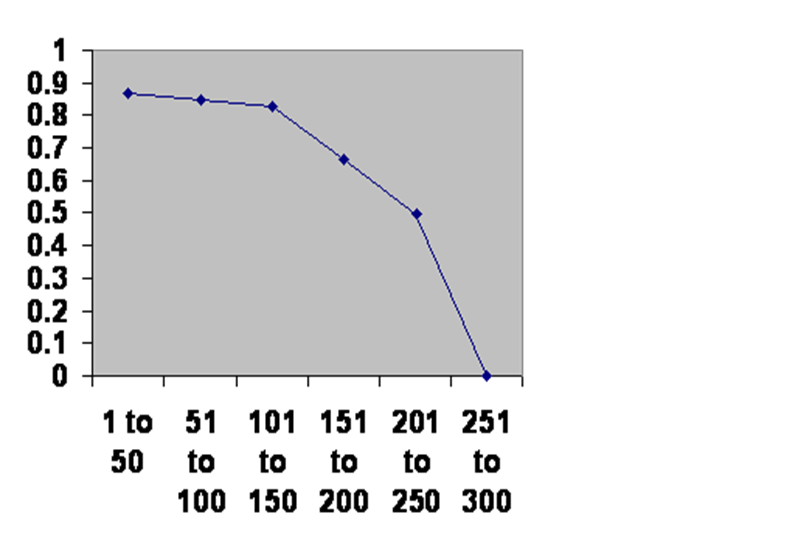
Most Dreaded Terror 11 farther West

It is the (roughly) the end of winter, 2018
In the last talk I was showing you the time course of collapse of civilizations (regimes, empires, what have you) in lower Mesopotamia. I also pooled the experience of Rome, the classical Mayans and the Anasazi. Rome was a bit tricky, since it survived for a long time in name while the ruling powers changed from time to time. For instance, the first rise of the emperors I considered a change. I drew the information from the BBC. I don’t have my source for the classical Mayans, but it appears that they went through about three clear cut changes. The Anasazi are now called the “ancestral Pueblos,” but I am a bit uneasy about that term. I certainly accept that they were related to modern Pueblos, but whether the ancients that are studied actually have modern descendants is problematic. If my records serve I drew from The Collapse of Complex Societies. Joseph A. Tainter. Cambridge University Press. Cambridge. Eighteenth printing, 2009.
As before the age of each regime when it fell is on the horizontal axis in 50 year increments. The vertical axis is its chance of surviving that half century after it has entered that half century. If death came from outside, the viability of a regime would have nothing to do with how long it was since it was founded, the line would be horizontal. If regimes differed significantly between populations, there would be selection and regimes that had lasted longer would continue to last longer; the line would rise. But the line again falls:

Chew on it. The line is clean as can be, so only one process must be a work knocking down these regimes. There is the same 300-year brick wall, so it must be the same mechanism. And the line goes down proving that the effective mechanism is neither within the population nor outside the population so it has to be the very fact of a population that is big enough, or an administrative class that is big enough, to serve the needs of a civilization.
I concede that there is a bit of overlap. The Romans did indeed once rule Mesopotamia, so they potentially figure in both graphs; knowing whether that is true would require more historical savvy than I have. A professional historian ought to be able to tell, but I have been unsuccessful in getting any expert to take an interest.
That simply overwhelms me. How any expert could look at this unmoved is baffling. It’s as if you were to spend your life looking at the mouth of a cave and watching what came and went. If a sheep goes in, a lot of roaring comes out but no sheep. Bats come and go. Bears come and go with the seasons. And then somebody tells you how to enter the cave safely and look around. It ought to be irresistible.
In fact, I don’t know how anybody could fail to be captivated. If I might digress with a little personal history: I have always dreamed copiously. When I was young my dreams were sweeter than they are now. I won’t complain; the frustrations in the dream are not so intense as the frustration of doing what I am now doing in vain. But the sweet dreams of youth do not return.
A down side of such dreaming was that I would awaken and yearn to return to the dream. Well and good; I’m sure such things are not rare. But sometimes the same wistful yearning would strike me when I was wide awake with no dream being remembered. I asked my parents what it was. I don’t think they understood any better than I do now. I assumed it was a fancy of youth and I would outgrow it, but middle age arrived and I still occasionally would feel it, sometimes when I was quite preoccupied with things of immediate importance.
I suspect poets have described it, Victorians mostly, including Edgar Allan Poe. But I have never known a word for the feeling. It was like I was homesick for something that had never happened. It was not unpleasant and was easily shrugged off, but it was an enduring feature of my inner landscape.
I happened to become involved in the issue of the health of US veterans. That deserves a talk all on its own except that it is not obviously related to the issue of the mechanism of inbreeding and outbreeding depression … well maybe don’t you know? … I mean if nature expects us to live in communities of a certain size and make-up … and if we don’t … sorry I can’t lead you to it with iron clad logic nor articles in prestige science journals … but maybe.
But moving back toward topic, putting somebody into combat is a horrible thing to do to them. So they day came when we went to war in Iraq.
Saddam Hussein had asked the US ambassador whether it would be all right to take the Kuwait oil fields. The US had been trying to get permission to put up a military base in Kuwait, but had been rebuffed, so instead of saying, “Try it and we’ll blow you to smithereens,” the American official said, “Arab borders are Arab business.”
Kuwait was overrun. The US moved troops into Saudi Arabia and then on a day invaded Kuwait to drive Iraq out. At least that’s how I remember it, which is my point. The truth of matters I am happy to leave to others.
So I literally was lying on my couch thinking, “This is an unnessary war, and they know perfectly well how terrible war is for all concerned. WHY?
“Why do people choose leaders who act upon the hatred of outsiders that normal people only mutter about? What such hatred in the first place? There must be a selective advantage to it. It has to be biological.
“Maybe societies, biggish ones, get unstable simply because of their big and diverse mating pool. How long does a society last anyway? Is there a clue in that?”
So I put together the numbers I showed you for lower Mesopotamia. The graph you have seen became to whole focus of my life.
Emotionally I have never recovered. Those sweet wistful dreaming moments vanished altogether. Nothing was left but the burning need to warn the world.
So how anybody can look at either of these graphs and then forget about them escapes me.